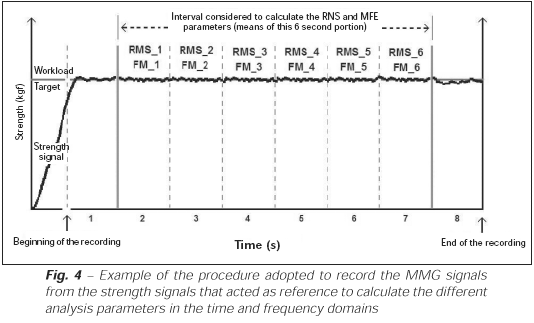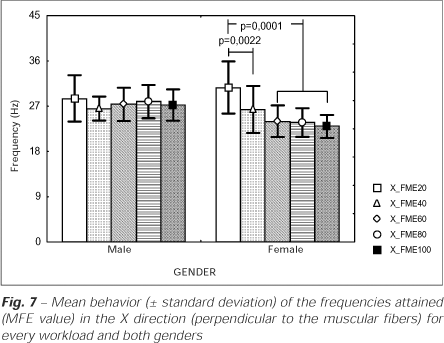The aim of this study was to characterize the temporal and spectral components of the muscle contractions in different contraction levels through the accelerometry. Fifteen male and twelve female right-handed individuals participated in this study. The trial was constituted by a maximal workload (MW) test that allowed to determine five different workloads (20%, 40%, 60%, 80% and 100% of MW) which, by its turn, allowed to determine five percentage workloads during the strength test (20%, 40%, 60%, 80%, and 100% of the MW) in isometry during eight seconds each of them. A biaxial accelerometer was put on the muscular abdomen of the right brachii biceps muscle. The mean square root (RMS value), a temporal parameter, and the mean frequency (MFE), a spectral parameter were extracted from the accelerometry signals (MMG signals). Such parameters were analyzed towards the X (perpendicular to the fibers) and Y (parallel to the fibers) directions. Both groups presented a descent behavior pattern of the loaded MFE (Y), and the most accentuated was the female group. The MFE variable (X) in the female group presented similar behavior before the MFE (Y), and it was observed a statistically significant difference only between 20% of the MW and every other workload (p = 0.0022 for 40% and p < 0.0001 for the remaining). The male group did not present any statistically significant difference between workloads. The RMS value (Y) presented an ascent behavior with the workload in both genders, presenting differences between the 20% and 40% workloads of the MW (p = 0.000), and 80% and 100% of the MW (p = 0.01) in the male group. But it was observed no statistically significant difference between workloads in the female group. It is argued that during the muscular contraction, there is non-uniform variations on the fiber's diameter, besides the low frequency lateral oscillations. Such information seems to have strong correlation between the type of the fibers, and this could contribute for a better clarification on the possible mechanisms involved in the gradation process of the muscular strength.
Mechanomyography; MMG; Vibromyography; VMG; Muscular contraction










